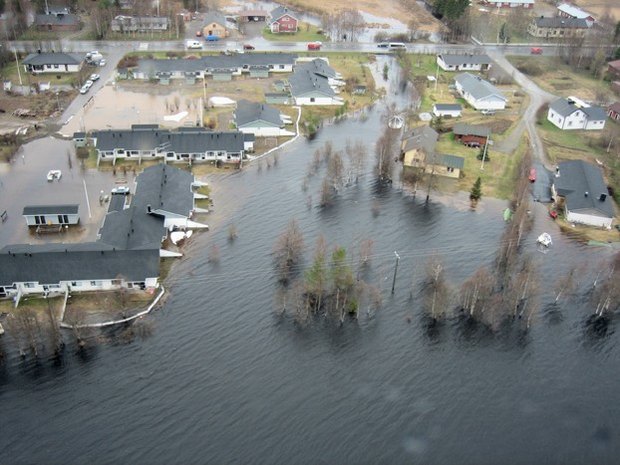
The Ounas river flooding in Kittilä in May 2005. - Photo: Lapin pelastuslaitos, Kittilä (Lapland's Emergency Service, Kittilä)
The Kittilä case study showed that climate change is viewed, by the municipal authorities at least, as presenting the city with positive opportunities rather than threats. Kittilä is located in a highland area with many fells and is, in winter, one of the most visited tourist resorts in Finland. Tourism in Lapland is expected to increase significantly in the coming years not least due to the decline in snowfall levels in the traditional Central European ski-resorts.
Flooding has already however caused severe damage in the area and their incidence is likely to increase in the future due to ongoing climate change. In addition, there will be serious impacts on the flora and fauna of the region, especially in the arctic areas. Such developments will thus have a negative impact on those economic sectors dependent on the natural environment, tourism included.
The latest severe flood in Kittilä took place in May 2005 as the Ounas River breached it banks due to the sudden pressure of fast melting snow.
The water reached its peak level in five days and had risen by 1.78 metres during this time. The municipality suffered economically as the massive flood protection measures undertaken required a significant amount of material and
work. In addition, the restoration of the damaged housing stock was also expensive.
The flood response operation and the cross-sectoral cooperation undertaken between the various concerned authorities was however described as a success. The most significant challenges in respect of flood response were connected to the level of risk knowledge among the citizens and municipal information responses.
On the other hand, many volunteers and private sector entrepreneurs were willing to participate in protection measures. Local people helped each other and a strong communal spirit emerged. The municipal authorities used the local radio station as a participant in its municipal information work. This proved to be an efficient way to inform inhabitants about the ongoing flood situation.
Nevertheless, even if a willingness to cooperate and participate in flood response did exist it was clear that a lack of knowledge about how, in practice, to handle flood protection measures remained. It also emerged that people seem easily to forget the lessons initially learned. After only a couple of years few in the town believed that a new flood was possible.
Several options for flood protection in Kittilä have been reviewed: flood protection embankments, building dams on the upper stretches of the river, cleaning the river bed and the implementation of temporary flood protection solutions.
Significant conflicts of interest have however emerged here. Flood protection
embankments and dams upriver are the options with the most potential at present. Embankments are in fact already being planned for June 2009. Embankments would primarily protect only the centre of Kittilä. Other sites downriver, such as for example the city of Rovaniemi, would however suffer even more severe floods due to this arrangement.
Some land owners and the village association of Kittilä are also against these plans because they would alter the scenic view. The dams on the other hand would offer a permanent solution to flood protection. In addition, dams can also be used to produce energy.
The 'problem' however is that the Ounas River is strictly protected by legislation. The Ounas River is the largest of Finland's un-dammed rivers. Legislation on the Ounas River was enacted in 1983. The law prohibits the building of hydro-electric dams on the river. The question of whether, despite the current legislative situation, dams could nevertheless be built for flood protection and energy production purposes, is currently under discussion. Dams would however represent a much more expensive solution
than the creation of flood protection embankments. On the other hand, if the hydroelectric company could use the dams to produce energy, then the funding question would be solved.
Municipalities are waiting for clear instructions on flood protection and climate change issues from the national level. At present, a distinct lack of clarity exists in respect of municipal responsibilities in this area; for example, what should the municipality do if there are old buildings in the new risk areas? Municipalities should nevertheless seek to play an active role. For example, the creation of a cross-sectoral municipal climate strategy planning process could prove to be a good starting point here.
By Leena Kurkela, Project Researcher